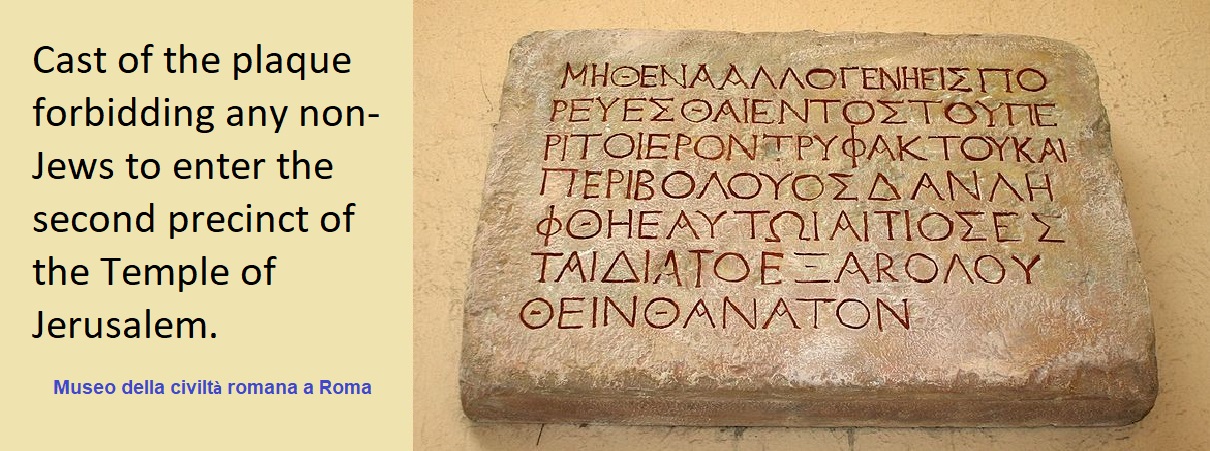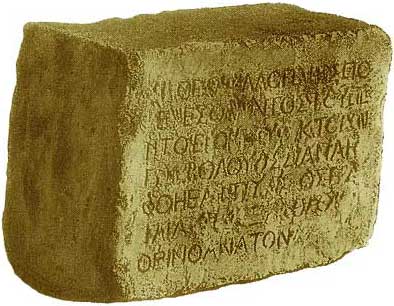
Biblical Evidence for the 1st Century Return of Christ
… parousiafulfilled.com
“For he himself is our peace, who has made us both one and has broken down in his flesh the dividing wall of hostility” (Eph 2:14)
The first humans, Adam and Eve, disobeyed the command of our Creator, Almighty God, in the garden of Eden and committed the first sin. As a result of their wickedness and rebellion, they were spiritually ‘dead’ and alienated from God. Their sin also caused enmity and alienation from each another. If left in that spiritually dead state, Adam and Eve and all their descendants (including you and me) would be forever separated from the Holy God, and destined to eternal punishment.
However, God is merciful and loving, “not wishing that any should perish, but that all should reach repentance.”(2 Peter 3:9). He did not abandon Adam and Eve to their fallen, spiritually dead state. Instead, he killed two animals as an atoning sacrifice… as substitutes to pay for their sin on their behalf: “And the Lord God made for Adam and for his wife garments of skins and clothed them.”(Gen 3:21)
This was the beginning of the substitutionary sacrifice system of atonement and reconciliation, and a ‘type’ of the ultimate perfect sacrifice: Jesus, the Son of God, whose death on the cross of Calvary (AD 30) was the final, once for all, atonement for the sins of the whole world. And so, Jesus Christ reconciled mankind to God:
“All this is from God, who through Christ reconciled us to himself and gave us the ministry of reconciliation; that is, in Christ God was reconciling the world to himself, not counting their trespasses against them, and entrusting to us the message of reconciliation.” (2 Cor 5:18-19)
Before Jesus came to earth, God created the nation of Israel and made a covenant with them, promising that, if they loved him and obeyed his commandments, they would be his special people and he would be their God. This was the Mosaic Covenant (the Old Covenant or OC). In order for the Israelites to worship him and offer regular sacrifices for their sins, God ‘dwelt among them’, at first in a temporary tent-like structure called the Tabernacle, but later in a permanent Temple built by King Solomon in Jerusalem.
When Solomon dedicated the Temple, he also prayed that foreigners would come and offer sacrifices and worship God in the Temple:
“Likewise, when a foreigner, who is not of your people Israel, comes from a far country for your name's sake (for they shall hear of your great name and your mighty hand, and of your outstretched arm), when he comes and prays toward this house, hear in heaven your dwelling place and do according to all for which the foreigner calls to you, in order that all the peoples of the earth may know your name and fear you, as do your people Israel, and that they may know that this house that I have built is called by your name.” (1 Kings 8:41-43)
Nevertheless, only ethnic Israelites were God’s special covenant people, enjoying the blessings of God’s providence and atonement for their sins. Foreigners (aka “gentiles”) could only become part of the Mosaic Covenant community by being circumcised, converting and observing all of the rituals of Judaism.
In 19 BC King Herod built a much larger Temple. He also incorporated a “soreg” wall 2, which excluded foreigners from the Sanctuary. Jewish historian, Flavius Josephus, describes this wall:
‘When you go through these [first] cloisters, unto the second [court of the] temple, there was a partition made of stone all round, whose height was three cubits: its construction was very elegant; upon it stood pillars, at equal distances from one another, declaring the law of purity, some in Greek, and some in Roman letters, that “no foreigner should go within that sanctuary” for that second [court of the] temple was called “the Sanctuary;” ’ (Wars of the Jews, 5.5.3 paras 193-14, 1)

In 1871, archaeologist Charles Simon Clermont-Ganneau uncovered physical evidence of this exclusion barrier at the north-western corner of the graveyard abutting the temple mount wall. It was a stone tablet from the ‘soreg’ wall, and written on it in Greek was the following warning:
“No stranger is to enter within the balustrade around the temple and enclosure. And whoever is caught will have himself to blame that his death ensues.”
His discovery is now held in the National Archaeological Museum in Istanbul. Another partial stone is held in the Israel Museum in Jerusalem.
In AD 70, the parousia of Christ brought the final judgement and wrath of God upon that last generation of Jews: the generation that rejected and killed their Messiah in AD 30. Josephus 1, records that 1.1 million people perished during the Roman siege of Jerusalem, while the survivors of the siege were taken captive and sold as slaves in the mines of Egypt or as entertainment in the arenas. The Jewish nation, including its people, Herod’s Temple, the priests and all its religious and political trappings was wiped out.
Physical barriers like the stone ‘soreg’ wall as well as religious and cultural barriers were obsolete and finally disappeared in the destruction of Jerusalem. The OC ended and the old barriers ceased to exist.
Apostle Paul tells us in Eph 2:14 that Christ has broken down “the dividing wall of hostility”, accomplishing in full, once and for all time, what the Mosaic Law could never achieve: the reconciliation of mankind to God and the reconciliation of the circumcised (Jews) to the uncircumcised (Gentiles), so that:
“he might create in himself one new man in place of the two, so making peace, and might reconcile us both to God in one body through the cross, thereby killing the hostility.” (Eph 2:11-16)
Note what God has created: “one new man in place of two” in “one body”. That everlasting body is the Christian Church.
“There is neither Jew nor Greek, there is neither slave nor free, there is no male and female, for you are all one in Christ Jesus.” (Gal 3:28)
Note that now, as a result of Christ’s ministry of reconciliation, there are no Jews or Greeks (gentiles) in the kingdom of God. There is only ONE new body, the Church, the body of Christ, in which all believers are equal and united by faith in our Saviour and Lord. This is the ‘new creation’.
The work of reconciliation was not fully completed until the last remnants of the OC theocracy were abolished and destroyed at the parousia. As Russell notes:
“The chosen people, the children of the Friend of God, the favoured nation, with whom the God of the whole earth deigned to enter into covenant and to be called their King, - were to be overwhelmed by the most terrible calamities that ever befell a nation; were to be expatriated, deprived of their nationality, excluded from their ancient and peculiar relation to God, and driven forth as wanderers on the face of the earth - a byword and hissing among all nations.” (The Parousia 3, p.64)
“Judaism was never constituted to be a universal religion; it was essentially limited and national in its operation; but Christianity is made for man, and has proved its adaptation to every variety of the human family.” (The Parousia 2, p.550)
Many more scriptures confirm this new heavenly order, this ‘new creation’. Consider these passages:
“For in one Spirit we were all baptized into one body ‐ Jews or Greeks, slaves or free ‐ and all were made to drink of one Spirit.” (1 Cor 12:13)
“There is one body and one Spirit ‐ just as you were called to the one hope that belongs to your call ‐ one Lord, one faith, one baptism, one God and Father of all, who is over all and through all and in all.” (Eph 4:4-6)
“For neither circumcision counts for anything, nor uncircumcision, but a new creation.” (Gal 6:15)
“Therefore, if anyone is in Christ, he is a new creation. The old has passed away; behold, the new has come.” (2 Cor 5:17)
Through his death and resurrection, Christ became the ultimate perfect substitutionary sacrifice for the sins of the whole world: there was no further need of animal sacrifices or earthly priests or outward fleshly rituals and ceremonies. For 40 years, from AD 30 to AD 70, the OC was obsolete and ready to fade away:
“By speaking of a new covenant, He has made the first one obsolete; and what is obsolete and aging will soon disappear.” (Heb 8:13)
Its removal and permanent abolition was accomplished at the parousia return of Christ in AD 70, and the New Covenant of grace in his blood was established forever.
He “has broken down in his flesh the dividing wall of hostility by abolishing the law of commandments expressed in ordinances”, so that He “might reconcile us both to God in one body through the cross”. As Russell observes, this reconciliation brought about:
“a glorious change in this world. The old made way for the new; the Law was replaced by the Gospel; Moses was superseded by Christ. The narrow and exclusive system, which embraced only a single people, was succeeded by a new and better covenant, which embraced the whole family of man, and knew no difference between Jew and Gentile, circumcised and uncircumcised. The dispensation of symbols and ceremonies, suited to the childhood of humanity, was merged in an order of things in which religion became a spiritual service, every place a temple, every worshipper a priest, and God the universal Father.” (The Parousia 3, p.64)
1… Josephus: The Complete Works, translated by Whiston, William. A.M., Thomas Nelson Publishers, Nashville 1998.
2… Soreg (or s’yag) is apparently a Hebrew word meaning: “middle wall of separation/partition”.
3… The Parousia: The New Testament Doctrine of Our Lord’s Second Coming by Russell, James Stuart, International Preterist Association, Bradford PA, 2003. (Originally published by T. Fisher Unwin, London, 1887).
copyright © 2019‐2023 Kenneth Higgs ‐ ParousiaFulfilled.com ‐ v2.01